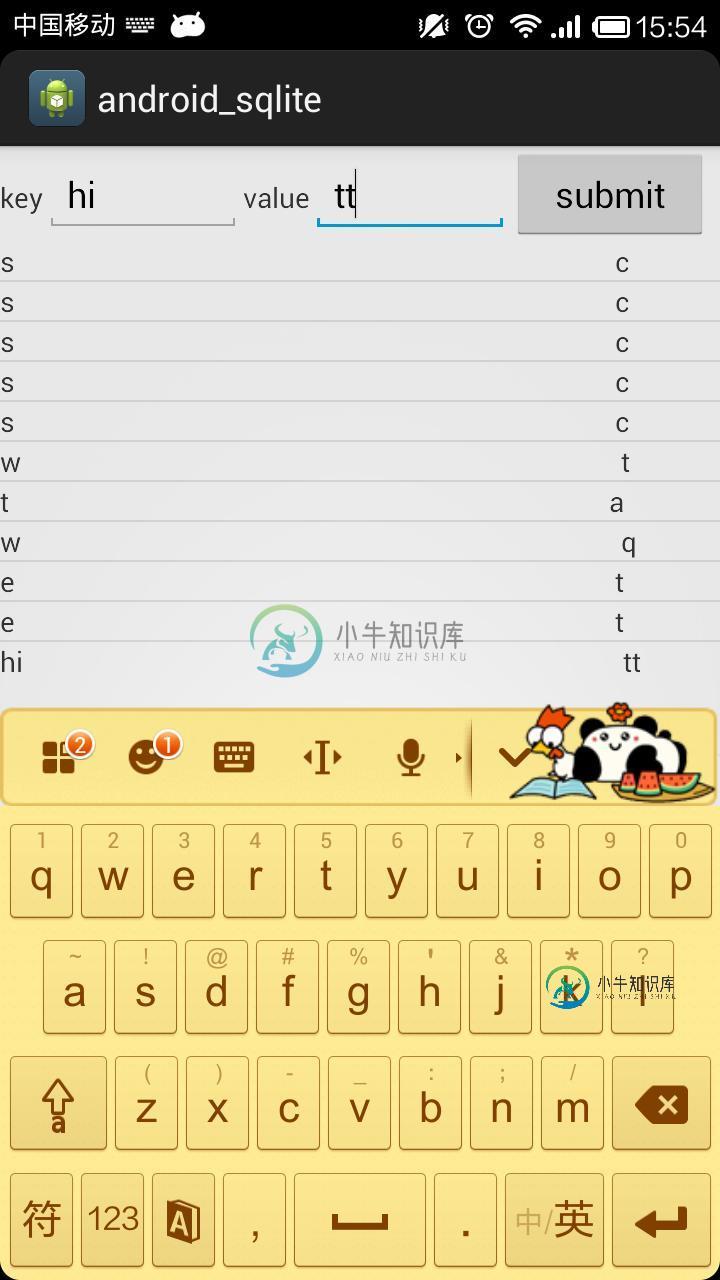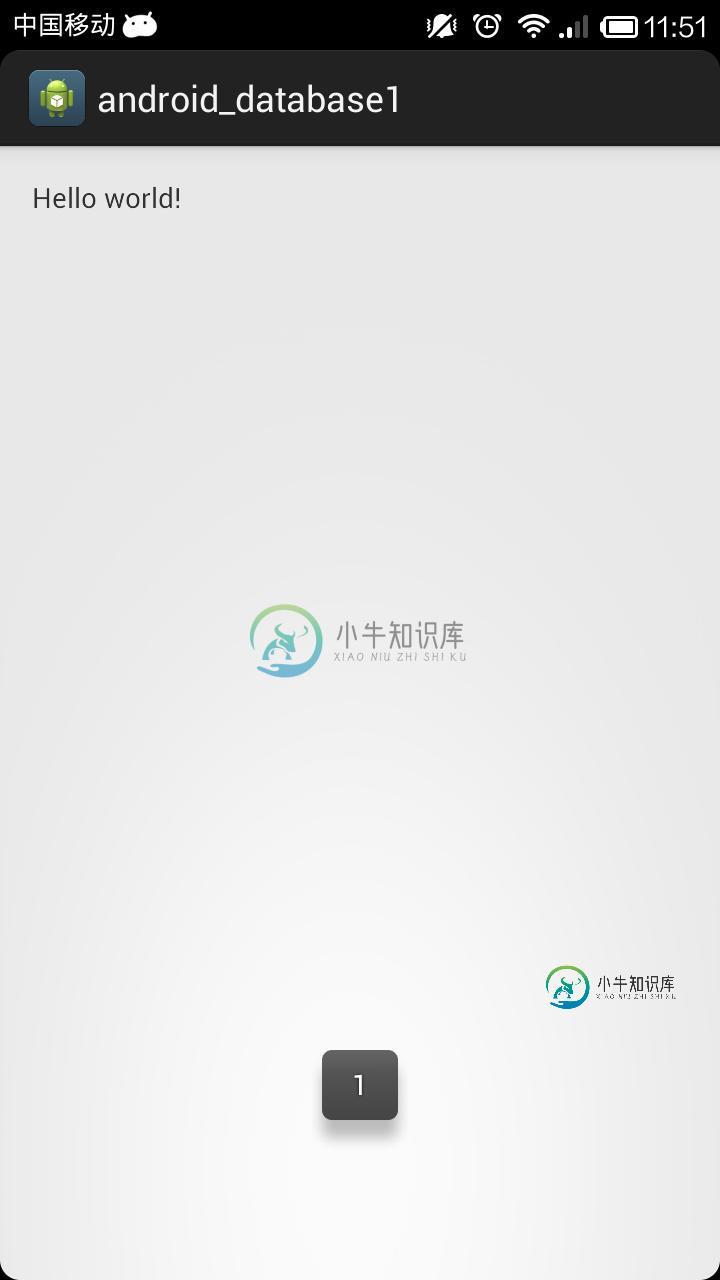实例讲解Android App使用自带的SQLite数据库的基本方法
SQLite数据库是android系统内嵌的数据库,小巧强大,能够满足大多数SQL语句的处理工作,而SQLite数据库仅仅是个文件而已。虽然SQLite的有点很多,但并不是如同PC端的mysql般强大,而且android系统中不允许通过JDBC操作远程数据库,所以只能通过webservice等手段于php、servlet交互获取数据。
基础
SQLiteDatabase类,代表了一个数据库对象,通过SQLiteDatabase来操作管理数据库。
一些基本的用法:
- static SQLiteDatabase openDatabase(String path,SQLiteDatabase.CUrsorFactory factory,int flag);
- static SQLiteDatabase openOrCreateDatabase(File file,SQLiteDatabase.CursorFactory factory);
- static SQLiteDatabase openOrCreateDatabase(String path,SQLiteDatabse.CursorFactory factory);
通过这些静态方法可以很方便的打开和新建一个数据库。
- execSQL(String sql,Object[] bindArgs)
- execSQL(String sql)
- rawQuery(String sql,String[] selectionArgs);
- beginTransaction()
- endTransaction()
这些函数可以完成SQL功能,对于查询出来的结果是用Cursor表示的,类似于JDBC中的ResultSet类,在这些类中通过方法move(int offset)、moveToFirst()、moveToLast()、moveToNext()、moveToPosition(int position)、moveToPrivious()获取需要的结果行。
下面通过一个实例来说明一下SQLiteDatabase的基本使用:
main.xml:
<LinearLayout xmlns:android="http://schemas.android.com/apk/res/android"
xmlns:tools="http://schemas.android.com/tools"
android:layout_width="match_parent"
android:layout_height="match_parent"
android:orientation="vertical"
tools:context=".Main" >
<LinearLayout
android:layout_width="match_parent"
android:layout_height="wrap_content"
android:orientation="horizontal" >
<TextView
android:layout_width="wrap_content"
android:layout_height="wrap_content"
android:gravity="center"
android:text="key" />
<EditText
android:id="@+id/keys"
android:layout_width="100sp"
android:layout_height="wrap_content" />
<TextView
android:layout_width="wrap_content"
android:layout_height="wrap_content"
android:gravity="center"
android:text="value" />
<EditText
android:id="@+id/values"
android:layout_width="100sp"
android:layout_height="wrap_content" />
<Button
android:id="@+id/btn"
android:layout_width="100sp"
android:layout_height="wrap_content"
android:text="submit" />
</LinearLayout>
<LinearLayout
android:layout_width="match_parent"
android:layout_height="wrap_content" >
<ListView
android:id="@+id/lv"
android:layout_width="match_parent"
android:layout_height="wrap_content" />
</LinearLayout>
</LinearLayout>
用于填充数据的mytextview.xml:
<?xml version="1.0" encoding="utf-8"?>
<LinearLayout xmlns:android="http://schemas.android.com/apk/res/android"
android:layout_width="match_parent"
android:layout_height="wrap_content"
android:orientation="horizontal" >
<TextView
android:id="@+id/listkey"
android:layout_width="wrap_content"
android:layout_height="wrap_content"
android:layout_gravity="left" />
<TextView
android:id="@+id/listvalue"
android:layout_width="wrap_content"
android:layout_height="wrap_content"
android:layout_marginLeft="300sp" />
</LinearLayout>
Main.java
package com.app.main;
import android.annotation.SuppressLint;
import android.app.Activity;
import android.database.Cursor;
import android.database.sqlite.SQLiteDatabase;
import android.os.Bundle;
import android.view.View;
import android.view.View.OnClickListener;
import android.widget.Button;
import android.widget.CursorAdapter;
import android.widget.EditText;
import android.widget.ListView;
import android.widget.SimpleCursorAdapter;
public class Main extends Activity {
EditText ed1 = null;
EditText ed2 = null;
Button btn = null;
ListView lv = null;
SQLiteDatabase db = null;
@Override
protected void onCreate(Bundle savedInstanceState) {
super.onCreate(savedInstanceState);
setContentView(R.layout.main);
ed1 = (EditText) this.findViewById(R.id.keys);
ed2 = (EditText) this.findViewById(R.id.values);
btn = (Button) this.findViewById(R.id.btn);
lv = (ListView) this.findViewById(R.id.lv);
db = SQLiteDatabase.openOrCreateDatabase(this.getFilesDir().toString()
+ "/my.db3", null);
btn.setOnClickListener(new OnClickListener() {
@Override
public void onClick(View view) {
String key = ed1.getText().toString();
String value = ed2.getText().toString();
try {
insertData(db, key, value);
Cursor cursor = db.rawQuery("select * from tb_info", null);
inflateListView(cursor);
} catch (Exception e) {
String sql = "create table tb_info(_id integer primary key autoincrement,db_key varchar(20),db_value varchar(50))";
db.execSQL(sql);
insertData(db, key, value);
Cursor cursor = db.rawQuery("select * from tb_info", null);
inflateListView(cursor);
}
}
});
}
// 向数据库中插入数据
private void insertData(SQLiteDatabase db, String key, String value) {
db.execSQL("insert into tb_info values (null,?,?)", new String[] { key,
value });
System.out.println("------------------");
}
// 向ListView中填充数据
@SuppressLint("NewApi")
public void inflateListView(Cursor cursor) {
SimpleCursorAdapter adapter = new SimpleCursorAdapter(Main.this,
R.layout.mytextview, cursor, new String[] { "db_key",
"db_value" },
new int[] { R.id.listkey, R.id.listvalue },
CursorAdapter.FLAG_REGISTER_CONTENT_OBSERVER);
lv.setAdapter(adapter);
}
@Override
protected void onDestroy() {
super.onDestroy();
if (db != null && db.isOpen()) {
db.close();
}
}
}
实现的效果:

需要特别指出,在用SimpleCursorAdapter封装Cursor的时候,要求底层数据库表的主键列的列名为_id,因为SimpleCursorAdapter只能识别主键列名为_id的表。
进阶
直接使用SQLiteDatabase的openOrCreateDatabase可以直接打开或者是新建一个SQLiteDatabase,但是这里存在一个缺点。在每次执行SQL语句的时候都需要在try catch语句中进行,如果在try中直接操作的数据库或者表不存在,就需要在catch中重新创建表并且执行CRUD操作,并且有关数据库的每一个方法都要这么做,重复的代码太多了,所以实际的开发中大都选用SQLiteOpenHelper类。
主要方法:
- synchronized SQLiteDatabase getReadableDatabase():以读写的方式打开数据库。
- synchronized SQLiteDatabase getWritableDatabase();以写的方式打开数据库。
- abstract void onCreate(SQLiteDatabase db) 当第一次创建数据库的时候回调该方法。
- abstract void onUprade(SQLiteDatabase db,int oldversion,int newVersion) 数据库版本更新的时候回调该方法。
- abstract void close() 关闭所有打开的SQLiteDatabase.
使用方法:
1)继承SQLiteOpenHelper。在构造方法中的参数String name就是数据库的名称。
2)重写onCreate和onUpgrade方法。
MySQLiteOpenHelper类:
package com.app.db;
import android.content.Context;
import android.database.sqlite.SQLiteDatabase;
import android.database.sqlite.SQLiteDatabase.CursorFactory;
import android.database.sqlite.SQLiteOpenHelper;
public class MySQLiteOpenHelper extends SQLiteOpenHelper {
String createSQL = "create table tb_test(_id integer primary key autoincrement ,name,age )";
public MySQLiteOpenHelper(Context context, String name,
CursorFactory factory, int version) {
super(context, name, factory, version);
}
@Override
public void onCreate(SQLiteDatabase db) {
db.execSQL(createSQL);
}
@Override
public void onUpgrade(SQLiteDatabase arg0, int arg1, int arg2) {
}
}
Main.java
package com.app.main;
import android.app.Activity;
import android.database.Cursor;
import android.database.sqlite.SQLiteDatabase;
import android.os.Bundle;
import android.view.Menu;
import android.widget.Toast;
import com.app.db.MySQLiteOpenHelper;
public class Main extends Activity {
@Override
protected void onCreate(Bundle savedInstanceState) {
super.onCreate(savedInstanceState);
setContentView(R.layout.main);
MySQLiteOpenHelper helper = new MySQLiteOpenHelper(this, "my.db3",
null, 1);
String insertSQL = "insert into tb_test values(null,'wx',18)";
SQLiteDatabase db = helper.getReadableDatabase();
db.execSQL(insertSQL);
Cursor cursor = db.rawQuery("select * from tb_test", null);
cursor.moveToFirst();
int id = cursor.getInt(0);
Toast.makeText(this, id+"",Toast.LENGTH_SHORT).show();
}
@Override
public boolean onCreateOptionsMenu(Menu menu) {
getMenuInflater().inflate(R.menu.main, menu);
return true;
}
}
实现效果:

-
本文向大家介绍基于require.js的使用(实例讲解),包括了基于require.js的使用(实例讲解)的使用技巧和注意事项,需要的朋友参考一下 本篇文章总结下require.js使用方法。 1.为什么使用require.js? 使用之前,我的页面的js是这样的 由于这些js代码一般都写在模板中,因此不管我的页面如何简单,用不用的到这么多js,这些js都会加载,而我们大家都知道,加载js时页面会
-
本文向大家介绍Android SQLite数据库基本操作方法,包括了Android SQLite数据库基本操作方法的使用技巧和注意事项,需要的朋友参考一下 程序的最主要的功能在于对数据进行操作,通过对数据进行操作来实现某个功能。而数据库就是很重要的一个方面的,Android中内置了小巧轻便,功能却很强的一个数据库–SQLite数据库。那么就来看一下在Android程序中怎么去操作SQLite数据库
-
本文向大家介绍基于iOS Realm数据库的使用实例详解,包括了基于iOS Realm数据库的使用实例详解的使用技巧和注意事项,需要的朋友参考一下 首先下载Realm源代码,https://realm.io/cn/docs/objc/latest 将下载的文件解压,从 ios/static/ 目录中将 Realm.framework 拖曳到 Xcode 工程的文件导航器内,然后在 Xcode 文件
-
本文向大家介绍C#连接SQL Server数据库的实例讲解,包括了C#连接SQL Server数据库的实例讲解的使用技巧和注意事项,需要的朋友参考一下 C#连接数据库:Connection对象 1.Connection对象概述 Connection对象是一个连接对象,主要功能是建立与物理数据库的连接。其主要包括4种访问数据库的对象类,也可称为数据提供程序,分别介绍如下。 SQL Server数据提
-
一个SQLite使用的简单例子。实现联系人信息的Demo,使用SQLite进行存取,并可以查询。 [Code4App.com]
-
本文向大家介绍ASP.NET操作MySql数据库的实例代码讲解,包括了ASP.NET操作MySql数据库的实例代码讲解的使用技巧和注意事项,需要的朋友参考一下 一、把MySql.Data.dll放到BIN目录下。 二、这是aspx.cs的全部源码,修改参数直接运行即可! 以上所述是小编给大家介绍的ASP.NET操作MySql数据库的实例代码讲解,希望对大家有所帮助,如果大家有任何疑问请给我留

